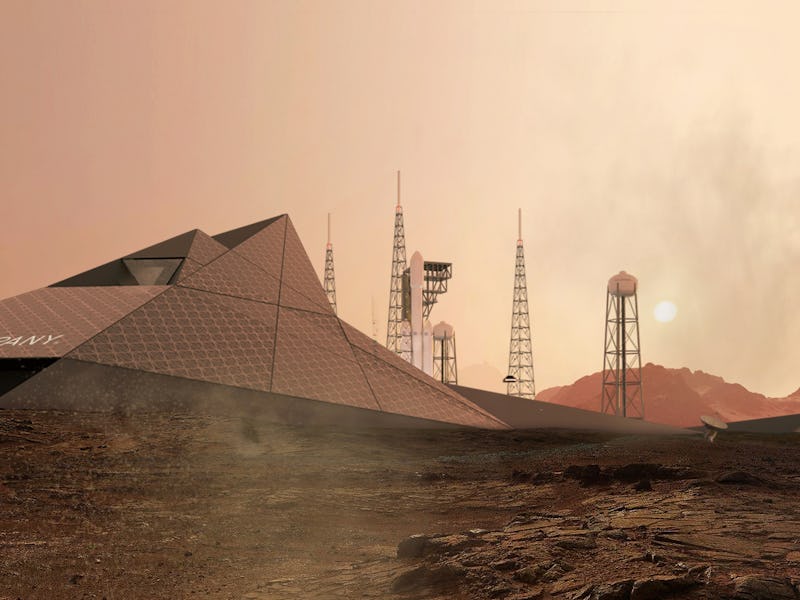SpaceX Mars city: 4 stunning concept images show planet’s fuel station
Air Company has produced a series of concept images showing what the refuel station for Mars' rockets could look like.

Could this be the gas station of the future?
In a new series of concept images, Mars fans get a sense of what a refueling station on Mars could look like. Such a resource would be a critical necessity for humans living on Mars to return to Earth — or venture further into the cosmos.
Air Company, a New York City-based technology company, announced Tuesday its plans to create rocket fuel from carbon dioxide. The firm tells Inverse it has a working prototype of a system that uses carbon dioxide, water, and solar energy to produce liquid oxygen and methane. These can then be used to power a rocket — much like the one SpaceX hopes to use to send the first humans to Mars.
The company's concept art envisions how this could be used to support a city on Mars. SpaceX CEO Elon Musk has described his plan to build a settlement on the planet by 2050, ostensibly supported by a refueling facility that harnesses Mars' resources to generate more fuel. Astronauts could then return to Earth from Mars, or set course for other cosmic bodies. Over time, humans could even create a planet-hopping network, allowing us to travel far out across the Solar System.
The station's interior.
SpaceX is currently developing the Starship, its first space rocket to be powered by liquid oxygen and methane. Musk suggested earlier this month that the first crewed Mars-bound Starship could launch in 2026.
"Our goal is to use our CO2 conversion technology and expertise to help groups like NASA, SpaceX and others enable human colonization throughout the solar system," Air Company co-founder Gregory Constantine tells Inverse.
Air Company's efforts have received recognition from NASA. In May 2019, the firm was picked as one of five winners of the first phase of the CO2 Conversion Challenge. The competition focuses on turning carbon dioxide into glucose, which could be used to make food and medicine on Mars. Air Company received $50,000 to help pursue its ideas further.
The facility exterior.
In April, Air Company started making hand sanitizer by converting carbon dioxide into ethanol. The company also launched a carbon-negative vodka at the end of August, created from carbon dioxide, solar energy, and water. Each 750-milliliter (25 fluid ounce) bottle removes about a pound of carbon dioxide from the air. GQ Magazine described it as tasting "clean and crisp like a shard of light."
It was during this product's development that the firm started exploring rocket fuel.
"We stumbled upon this application of our technology when working on improvements to our existing pilot plant that converts CO2 to alcohols, and we were motivated by the work that we were doing for NASA for their CO2 Conversion Challenge to continue to pursue it," Constantine says.
The ship refueling.
Musk himself described in September 2016 how such a facility would work. Water would be collected from Mars' ice reserves, estimated to measure around five million cubic kilometers. Carbon dioxide would come from the atmosphere, estimated to be around 25 trillion metric tons. Electrolysis would split the water into oxygen and hydrogen, and the Sabatier process would be used to take carbon dioxide and hydrogen to create methane and more water.
Musk's plan.
The process is similar to one described by NASA's David Williams in 2005, although he called for bringing hydrogen from Earth rather than attempting to harvest water ice. NASA's MOXIE experiment, launched with the Perseverance rover in August, is designed to produce oxygen from the carbon dioxide in the atmosphere.
This is expected to be an energy-intensive process — Musk estimated in October 2019 that it would require around one to 10 megawatts of solar energy.
The station from another view.
Eagle-eyed fans may note that while Air Company's concepts appear to show a Falcon Heavy rocket (around 230 feet tall), SpaceX plans to use the much larger (around 400 feet tall) Starship for Earth-to-Mars missions.
A company spokesperson explained:
"While Starship is the focus for SpaceX to achieve a load capacity to be able to service Earth orbit, the Moon and Mars, we've utilised our concepts to focus on what else could be possible in the future. As these designs are conceptual, our hope is that at some point there will be an array of types of rockets that could eventually make it to places like Mars that go beyond what is planned for the Starship."
With Air Company's working prototype ready, the team is now looking to spend the next 12 months to develop it further.
"We hope to get a chance to deploy this on a ship bound for a space station or Mars in the coming years to show our technology's usefulness for space colonization," Constantine says.
This article was originally published on